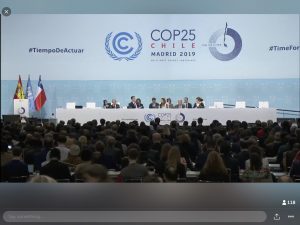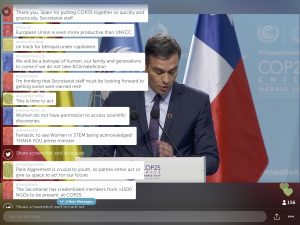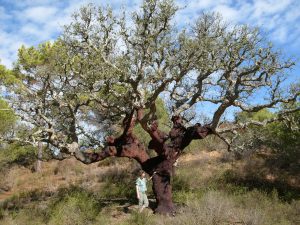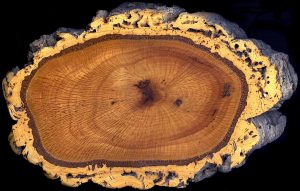By Dawn Bazely
Civil Society at the Climate Change Negotiations in Spain
The 25th annual “Conference of the Parties” to the United Nations Convention on Climate Change is currently meeting from December 2-13, 2019, in Madrid, though hosted by Chile.
Alongside the official delegations from different countries, thousands of members of civil society, from farmers to trade unionists, to business people and university researchers show up each year, to observe the negotiations, meet each other, network and plan action. They belong to organizations that have applied for and received official “observer status”. This includes Faith Based Organizations, many of which have long participated in the dialogue about how to act climate change and biodiversity loss. Pope Francis’ second encyclical, on Climate Change and Inequality, Laudato Si’, released in 2015, speaks to the Ecological Crisis (chapter 3). It’s available to download from the Vatican website.
This year, my academic duties prevented me from being in Spain as a member of the York University delegation. However, in my role as the university’s UN Designated Contact Point, I provide logistical support for our COP25 delegates.
In 2009, I applied for York University (Toronto) to be admitted as a non-governmental organization at the Climate Change Negotiations. We are a member of the RINGO or Research and Independent Non-governmental Organizations constituency. In the run-up to the annual fortnight-long COP, I apply for the sought-after credentials. Getting through the doors of the negotiations as an observer is immensely valuable for faculty and student researchers studying climate change science, policy, governance and politics.
Making time to write an Advent Botany post about an unusual custom
I thought that I wouldn’t have time to write an Advent Botany post this year, but while researching general information for the delegation about what’s happening outside of the enormous Conference of the Parties, I came across an Advent Season tradition in Catalonia, to the northeast of Spain, of which I had never heard. The Tió de Nadal or “Christmas Log” is also known as the Caga Tió or “pooping log”

Made from a small log of wood, it has a painted face, two front legs, a blanket draped over it, and it sometimes, wears a hat.
In my online research, I could not discover exactly how far outside of Catalonia this tradition extends, so I will most definitely be asking York University delegates to keep an eye out for them when they leave the UN venue to explore Madrid!
Beginning on December 8th, the Feast of the Immaculate Conception, children begin giving their log food and water. Naturally, these items disappear. On Christmas Day, the children beat the log, singing a song to it, demanding sweets, which along with other treats are found under the blanket, apparently having been excreted from the log. In the past, the log would then be burned, but these days, the cherished item is most likely put away with the Christmas decorations until the following December.
Stories about the Tió de Nadal have recently featured in the New York Times, the Smithsonian Magaine and The Independent. In a 2018 “Letter of Recommendation” in the New York Times magazine, Marta Bausells explained that this custom could be traced back to the Middle Ages in the Pyrenees. Lyndsay Patterson writing for the US National Public Radio’s Food History and Culture website, The Salt, in 2017, was told this during a visit to the Department of Popular Culture in Barcelona.
Bausells also explained that Catalan culture is very much concerned with the scatological, as perhaps, indeed, we all should be, since “we are what we eat, minus what we excrete”. One of my most highly cited research papers is on the role of lesser snow goose droppings in the nitrogen cycle of a salt-marsh! Catalan Nativity scenes include a pooping young man who shows up in Benito Cereno and Anthony Clark’s children’s comic book about the Tió de Nadal custom.
The Christmas Logs are made from Cork Oaks
I wondered what kind of trees Caga Tió logs were made from. Again, my online research in English, didn’t uncover any specific information, and I have never visited forests in Spain. Fortunately, Dr. Alastair Culham (co-founder of the Advent Botany blog series) took a look at some of the online photos of the logs, and identified them as cork oak, Quercus suber.
The Future Forest Partnership is a group of European regions, including Catalonia, sharing ideas about how European forests could adapt to climate change. An anonymous, undated document from this website, with citations up to 2012, reports that forest cover in the region is around 61%. While the types of forest include cork oak communities, which provide various forest products, the main tree species that is harvested is Scots Pine (Pinus sylvestris). There are many different species of pine and oak in Catalan forests, so I would guess that sometimes, the Christmas log is made from a pine tree.
In fact, anyone can make a Caga Tió with whatever logs you have on hand, and Bill Yovino gives instructions in a 2017 blog post!
References
Bausells, M. Letter of Recommendation: Tió de Nadal, New York Times Magazine. December 20, 2018. https://www.nytimes.com/2018/12/20/magazine/letter-of-recommendation-tio-de-nadal.html (retrieved 2-12-2019)
Fessenden, M. In Catalonia a Christmas Log Delivers Presents in An Unusual Way December 24, 2014. Smithsonian Magazine. https://www.smithsonianmag.com/smart-news/catalonia-christmas-log-delivers-presents-unusual-way-180953736/ (retrieved 2-12-2019)
Patterson, L. A Catalan Log that Poops Nougats at Christmas. NPR The Salt: Food History & Culture. December 22, 2017. https://www.npr.org/sections/thesalt/2017/12/22/572569325/caga-ti-a-catalan-log-that-poops-nougats-at-christmas (retrieved 2-12-2019)
Ritschel, C. Meet Tió de Nada, Catalonia’s Smiling Christmas Log that Defecates Presents. The Independent. December 4, 2017. https://www.independent.co.uk/life-style/catalonia-tio-de-nadal-christmas-log-tradition-presents-what-is-it-a8091921.html (retrieved 2-12-2019)
Online sources
https://theconversation.com/how-citizens-are-fighting-climate-change-on-the-global-stage-85884
https://en.wikipedia.org/wiki/Tió_de_Nadal
https://www.catholicculture.org/culture/liturgicalyear/calendar/day.cfm?date=2019-12-09
http://www.futureforest.eu/tempsite/index.php?lang=en
http://www.futureforest.eu/uploads/basic_document_catalonia_v2.pdf
https://billyovino.weebly.com/life/caga-tio-a-catalan-christmas-tradition




